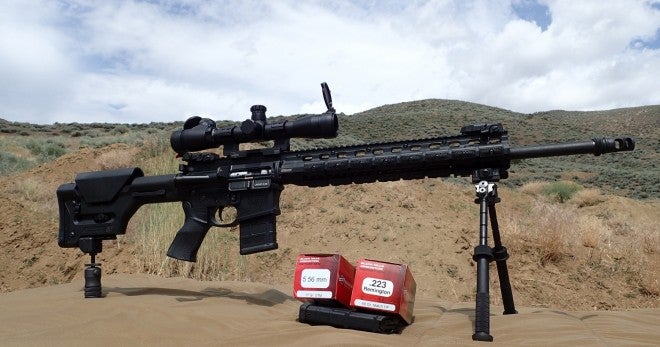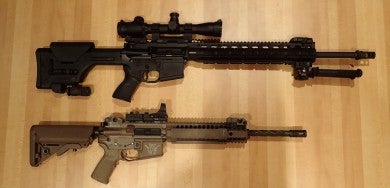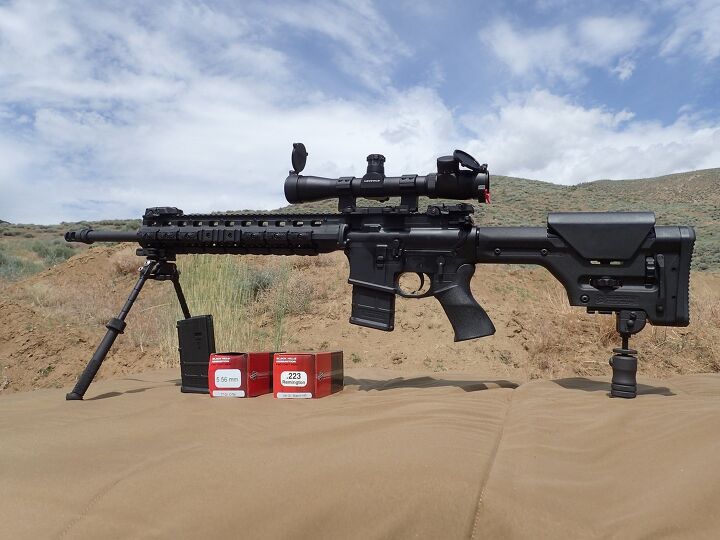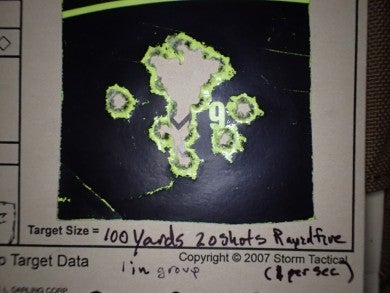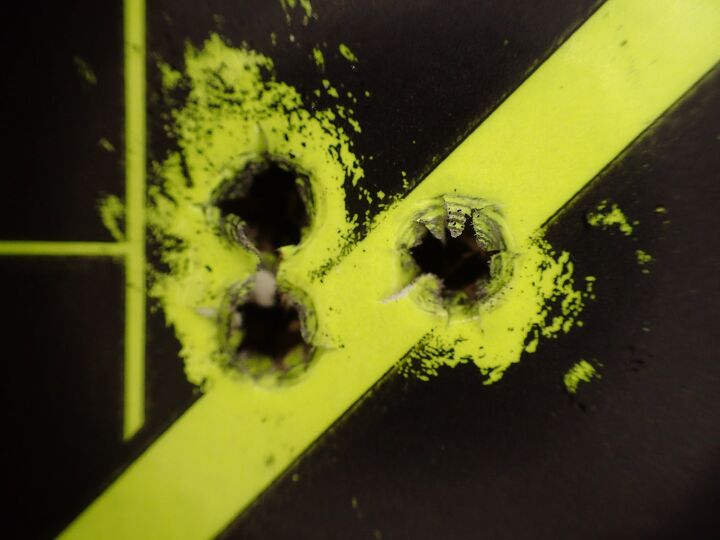“The Dead Center of Precision” is LaRue Tactical’s byline. With the LaRue OBR 5.56 20″, that’s exactly what I paid for, and exactly what I received. The world of the MSR is certainly a crowded one. It takes something extra to stand out in such a crowded market. I was familiar with LaRue from their excellent optic mounts, which I had used before, but had yet to handle one of their ARs. I was able to handle one at SHOT show in 2011, and was very impressed by the quality. There was zero “play” between upper and lower receivers, and between the receiver and rail section. Unlike some other tightly fitted ARs, however, you could still push out the receiver pins without using a punch. After handling the rifle, I was certain I would like to eventually own one.
I ordered mine in 2012 after reading many customer reviews, all of them positive in the accuracy and quality department. This was prior to a buying panic/their decision to produce barrels in-house. They actually had one in stock and shipped it that day to me. I didn’t realize how lucky I was on that count until later. The price back then was 2,245.00, same as it is now.
Features (per LaRue’s website):
- Guaranteed sub-MOA accuracy (with Federal GMM, 77 grain ammo)
- Proprietary handguard design keeps the rifle cool, aids in accuracy and ease of handling
- Unique fully freefloating barrel and barrel-nut design, that does not touch the handguard at any point, aids in accuracy
- Upper, lower and rails are CNC-machined from aluminum, Type-III hard anodized
- 10 MOA built into a continuous, T-marked, 1-piece upper rail
- Drop-down at rear of rail, for zero MOA when using iron sights
- Lower is low-shelf, to accommodate RDIAS
- Flared magwell allows faster mag changes
- Large trigger opening, with integral trigger guard
- Bolts and bolt carriers are hand-polished hard-chrome, in M16 profile
- Barrels are available in 12”, 16.1″, 18″ & 20″ lengths
- 1/8 twist-rate rifling.
- 10,000-round barrel life (approx)
- Muzzle threading: ½ x 28
- Direct gas-impingement: 12” is carbine-length, 16” and 18” are mid-length, and 20” is rifle-length
- Port Selector Technology (PST) gas block
- Mil-Spec receiver extensions on 12”, 16” and 18”
- Three, 3” long, MIL-STD-1913 detachable rail sections (and mounting hardware) included
- LaRue RAT Stock on 12”, 16”, and 18” models (The 20” comes with an A2 Stock, in black).
- LaRue medium A-PEG Grip™, on 12”, 16”, 18″, and 20″ models.
- Rifle Weight: 7.5 lbs (based on 16.1” barrel version, unloaded without optics and accessories)
- Trigger: LaRue MBT
I chose the 20″ OBR 5.56 because I already had mid length gas system ARs and wanted a rifle-length gas system. I originally was getting it as a rifle to easily engage in precision shooting out to 500 yards with minimal recoil, though since then I have stretched it’s legs a lot further. My OBR circa 2012 came with a 20″ LW-50 barrel. The new OBRs come with LaRue’s in-house barrels. I called LaRue to ask if they were made in the exact same fashion as the LW-50 barrels, and the reply I received was “that’s confidential”. The rifle itself came in a nice enough plastic hardcase, with a copy of the shot target from QC verifying that the rifle was sub-moa. It was a .485in group at 100 yards using Federal Gold Medal Match 77gr. One of the first things that I found different about the OBR was how the handguard interfaced with the upper receiver. Both the upper and the handguard have a flanged portion that interfaces together using hex bolts. This certainly aids in making sure the top rail is properly positioned for its entirety. Fit and finish, as I expected, was flawless. The trigger is a Giessele 2-stage trigger. The first stage is 2.5 lbs, the second 2. My Lyman digital gauge confirmed this, it is one of the most consistent triggers I have as far as the pull weight. Normally, I do not use 2-stage triggers, but I really do like the Giessele It is crisp, consistent, and reliable. New OBRs have LaRue’s MBT trigger.
I made 2 modifications to the rifle that were different from its factory configuration. I added an AAC Blackout 51T Brake to interface with an M4-2000 suppressor, and a Magpul PRS stock. The optic I ended up mounting on the rifle is a Leupold Mk4 MR/T 2.5-8x36mm in a LaRue OBR mount. I also mounted an Atlas bipod and rear monopod. The rifle as configured weighs roughly 11 pounds.
Range time:
Rarely has my first sight-in session with a rifle been so easy and rewarding as it was with the OBR. My first group out of the gun was .618 inches with Magpul MBUS sights (I believe the A2 front sight post covers 10 MOA at 100 yards when on a rifle with a 20″ barrel). I rarely keep shot targets, but I filed that one away. I had a lot of 68gr ammunition on hand at the time, but being that the gun was designed for 77gr, I needed to order some. I was able to get a better price on cases of Black Hills’ 77gr OTM rounds, which are the retail-sales available version of their MK262 Mod1 round. It’s the exact same ammunition, just in a much nicer box than the military rounds. My tightest group with the 77gr, using an optic, was .332in at 100yds. During that range session, I fired 60 rounds rapidly at various steel targets, and then immediately shot another group without cleaning the barrel. Despite the hot barrel, that group measured .756in. That is a testament to the quality of the OBR. POI shift with the suppressor mounted has consistently been 2.3in low at 100, in several different environmental conditions. POI shift using Black Hills 68gr OTM ammunition is .5in high at 100yds. All groups with the exception of the iron sights were shot using Atlas bipod and rear monopod. That particular group was shot prone. Another impressive group was a 20-round rapid-fire group that measured 1in at 100, firing 1 shot per second. Between the heavy weight, rifle-length gas system, and smooth functioning, follow-up shots an rapid fire strings are extremely easy.
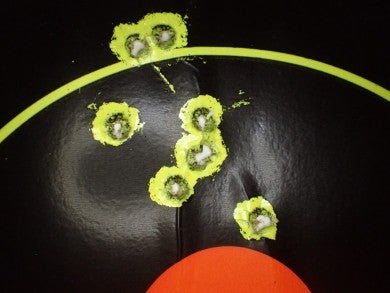
My first target sighting in with the MBUS sights. The high shots at 11 o’clock and the low one at 5 were adjusted for before the center 3.
Long-range accuracy has been excellent. I have engaged paper and reactive targets out to 500 yards, and steel with the rifle all the way out to 860 yards. Hits out to 500 are ridiculously easy and repeatable. The 860-yard target requires a little more care to hit. As long as the wind is consistent, though, it is no hard task. Environmental conditions seem to not affect the rifle too much, with hits being consistent through 80 degrees of temperature variation and precipitation ranging from snow to rain. I have fired over 2000 rounds through the rifle so far both suppressed and unsuppressed. I have had zero failures to function that were not associated with faulty magazines (I had a c products and a surefire 60-rounder both fail). I have not had to use the PST block with the suppressor attached, as there have been no functioning issues. Another nice thing about the OBR is I have experienced zero gas leakage out of the rear of the receiver while shooting suppressed! This speaks to LaRue’s attention to detail and tight tolerances in the gas system. The rifle has functioned well using all generations of Magpuls, USGI, HK steel, and lancer magazines. I prefer to use 20-round Magpuls with it, however, due to the fact that I usually shoot it prone or off the bench. I have also had zero FTEs with the rifle, so the “XTRAXN” technology must be working. Despite it’s relatively heavy weight, the rifle balances well. I have shot it offhand out to 400 yards with success.
Cleaning/care:
The OBR does not need babying at the range with constant barrel and chamber cleanings. I have shot 400 rounds through it one range session, and it still held sub-MOA. The hand-polished hard chrome bolt and carrier wipe clean easily even without solvent, even after suppressed shooting. I have not seen any degradation of the bore or rifling after 2000 rounds. Even if one does reach the end of its barrel life, LaRue now offers complete barrel cartridges for the OBR.
The LaRue OBR 5.56 20″ has lived up to its reputation as an extremely accurate, reliable rifle. Over the past 3 years, it has been and continues to be one of the most consistently accurate and reliable rifles I own, and in a semiauto platform to boot. I harbor no compunctions about its price, being that it has delivered in every way. With the OBR, LaRue has a real winner.
Pros:
- Extreme, guaranteed accuracy
- Flawless reliability so far
- High quality in all components
Cons:
- Less customizable from the factory than other competitors in its price range
 Your Privacy Choices
Your Privacy Choices
